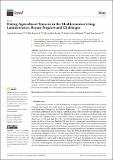Files in this item
Dating agricultural terraces in the Mediterranean using luminescence : recent progress and challenges
Item metadata
| dc.contributor.author | Srivastava, Aayush | |
| dc.contributor.author | Kinnaird, Tim | |
| dc.contributor.author | Sevara, Christopher | |
| dc.contributor.author | Holcomb, Justin A. | |
| dc.contributor.author | Turner, Sam | |
| dc.date.accessioned | 2023-03-21T15:30:08Z | |
| dc.date.available | 2023-03-21T15:30:08Z | |
| dc.date.issued | 2023-03-21 | |
| dc.identifier | 283823886 | |
| dc.identifier | e68f7aa7-96f2-46dd-a8f1-d2a270f06953 | |
| dc.identifier | 85151348630 | |
| dc.identifier.citation | Srivastava , A , Kinnaird , T , Sevara , C , Holcomb , J A & Turner , S 2023 , ' Dating agricultural terraces in the Mediterranean using luminescence : recent progress and challenges ' , Land , vol. 12 , no. 3 , 716 . https://doi.org/10.3390/land12030716 | en |
| dc.identifier.issn | 2073-445X | |
| dc.identifier.other | RIS: urn:508384635D86A404A783C4CD95407D0B | |
| dc.identifier.uri | https://hdl.handle.net/10023/27236 | |
| dc.description | Funding: This paper derives from the TerraSAgE project (Terraces as Sustainable Agricultural Environments) which is funded by the UK Arts and Humanities Research Council [grant number: AH/T000104/1]. | en |
| dc.description.abstract | Agricultural terraces provide farmers in hilly landscapes with effective ways to increase the area available for crops. They mitigate the risks of soil erosion and promote crop productivity by slowing surface water runoff and retaining moisture. As in other parts of the world, terraces have been constructed and used in the Mediterranean for millennia. The availability of terraced agriculture had important socio-economic, ecological, and environmental implications for past societies. However, the chronology of construction, use, and abandonment of terraces in different regions remains uncertain. A more robust set of chronological data will allow better assessment of whether terrace agriculture was a resilient strategy in the face of past economic or ecological instability and, in turn, inform how terraces could be used to address future agricultural and environmental challenges. In this paper, we review the application of luminescence dating to terrace sediments, the key challenges involved, and the currently published data which include over 250 luminescence ages. We also discuss the use of a multidisciplinary approach involving other geoarchaeological tools (e.g., use of GIS analyses, field-based luminescence readers, and micromorphology) to enhance the ways that past terrace systems can be understood. Terrace systems are inextricably linked to sustainable land use across the Mediterranean. Luminescence dating methods, therefore, have a crucial role to play in understanding the complexities of past and future landscape change. | |
| dc.format.extent | 19 | |
| dc.format.extent | 2961652 | |
| dc.language.iso | eng | |
| dc.relation.ispartof | Land | en |
| dc.subject | Agricultural terraces | en |
| dc.subject | Mediterranean | en |
| dc.subject | Luminescence dating | en |
| dc.subject | Landscape archaeology | en |
| dc.subject | CC Archaeology | en |
| dc.subject | GE Environmental Sciences | en |
| dc.subject | SDG 15 - Life on Land | en |
| dc.subject | MCC | en |
| dc.subject.lcc | CC | en |
| dc.subject.lcc | GE | en |
| dc.title | Dating agricultural terraces in the Mediterranean using luminescence : recent progress and challenges | en |
| dc.type | Journal item | en |
| dc.contributor.institution | University of St Andrews. School of Earth & Environmental Sciences | en |
| dc.identifier.doi | https://doi.org/10.3390/land12030716 | |
| dc.description.status | Peer reviewed | en |
This item appears in the following Collection(s)
Items in the St Andrews Research Repository are protected by copyright, with all rights reserved, unless otherwise indicated.

